Viewing search results for "State Archives of North Carolina"
View All Posts
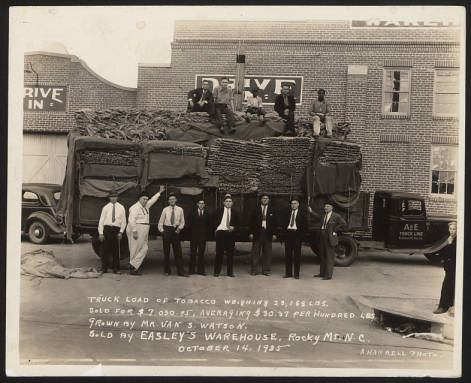
Truck Load of Tobacco Weighing 23,188 lbs. From Braswell Memorial Library.
We’re excited to announce that we’re partnering with the State Archives of North Carolina on an initiative that will help current and new partners prepare and transport their materials to the Digital Heritage Center for scanning. Participants will attend workshops on describing materials and getting them ready for digitization. The State Archives will also provide for transport of materials to and from the Digital Heritage Center. We’re hoping this will be especially helpful for those furthest from Chapel Hill. The State Archives’ blog includes information about the program and a link to the application. The application deadline is March 16. Please let us know if you have any questions or need assistance filling out the application.
This program is funded through a grant awarded to the State Historical Records Advisory Board and the State Archives of North Carolina and, as such, the opportunity won’t be around forever. It is open to current Digital Heritage Center partners as well as any institution or organization eligible to become a partner. We hope you’ll share the word with organizations who may be interested.
Thanks to our newest partner, William B. Umstead State Park (WBU), a batch containing over 150 new records are now available on DigitalNC. This batch holds a wealth of William B. Umstead State Park’s history featuring everything from plats, detailed construction plans of the park during the Great Depression when the Civilian Conservation Corps (CCC) was active, blueprints of a swimming pool, plans for the segregated park areas, plant information, planting schedules, and much more. One of many fascinating finds in this batch was the mention of the Camp Polk Prison Farm (also referred to as Cary Farm) on an ownership map of what would become the Crabtree Creek Recreational Area (now WBU) and the CCC era building plans.
In 1920, the Central Prison bought the former World War I tank training facility site and converted it into the Camp Polk Prison Farm. Totaling around 2,700 acres, the farm was equipped with livestock, modern farm equipment and machinery, cotton gin, dairy, saw mill, along with a modern fireproof brick and steel dormitory built using prison labor.
According to the November 1928 issue of Prison News, Camp Polk Prison Farm was set aside as a juvenile farm for white male prisoners under 21 to separate them from the older, seasoned criminals. However, not all prisoners under 21 were automatically qualified to be placed at Camp Polk farm. Mr. Pou, superintendent of the state’s prison at the time, notes only individuals who showed adaptability and “a readiness to deserve the favors tendered.” While at the farm the prisoners were required to work doing farm cropping, clearing new lands, canning, running the diary, and other tasks. Prisoners were also given the opportunity to receive instruction at night from individuals who were noted as educated and/or “capable honor grade” prisoners.
By 1927 the farm was a very profitable investment for the Central Prison. The September 1927 issue of Prison News, reported that the prison camp was “producing a great portion of its meats and food stuffs as well as supplying the Central Prison and the camps in part with fresh vegetables […]” and was “reputed to be worth by capable authorities easily over a half million dollars more than its cost to the State seven years ago, and has proved one of the best investments the State every made.”
Working collaboratively, state and federal agencies purchased 5,000 acres of land which included the Camp Polk Prison Camp under the federal Farm Resettlement Administration to develop a recreation area in 1934. The Crabtree Creek Recreational Area (now WBU) project provided jobs to individuals through the CCC and Works Progress Administration. Three years after the purchase of land, in 1937, the park opened with four camps along with day-use and picnic facilities. Plans and maps of the area and buildings during this period are present in this batch, including the latrine plans for the east, west, and middle units in Camp 2-G seen above.
In 1943, North Carolina bought the recreational area from the federal government for $1 and it was renamed to Crabtree Creek State Park. Although the park was not officially segregated up to this point, it was established that there were two separate entrance for white and Black individuals. In April 1950, however, the State of North Carolina officially segregated the park after converting 1,234 acres in the southern section into a Black park which was named Reedy Creek State Park. The white park retained the Crabtree Creek State Park name until 1955 when it was changed to William B. Umstead State Park. In the early 1960s, the parks were desegregated and eventually recombined in 1966 to form under the name William B. Umstead State Park. However, the impression of racial segregation can still be seen today with the park’s two separate entrances.
To learn more about William B. Umstead State Park, visit their website here.
To view more maps of North Carolina available on DigitalNC, click here.
Information on the World War I Camp Polk Tank Training Facility was gathered from the NCSU Special Collections and the State Archives Military Collections.
Information on the history of William B. Umstead State Park was gathered from the following NCPedia entries: Crabtree Creek State Park, Reedy Creek State Park, and William B. Umstead State Park.
Information about Camp Polk Prison Camp was gathered from issues of Prison News, which is available through the State Archives of North Carolina’s Digital Collections.
Thanks to our partner Randolph Community College, we’ve uploaded audio tapes of 62 interviews and discussions that informed the work Cultural Leadership Inside America’s Community Colleges by George Baker and contributors. Each interview asks an outstanding community college president or leader a series of questions about their leadership style and their vision for the future of their institution.
The large collection of tapes from interviewees around the country offers a great opportunity for teaching with primary sources; here are three ideas for how these materials could be used.
1. Journalism: What makes a good interviewer?
Although the interviewers in these tapes are rarely identified by name, their interviewing styles vary. Having a team of researchers ask the same set of questions makes it easier to identify some of the strategies that each person uses to engage their subject. Here are a few examples:
2. Representation & Gender
According to the American Association for Women in Community Colleges, close to 30% of community college presidents in 2020 were women. At the time of the recorded study, the researchers note that the proportion of women was closer to 7% (according to Baker and Rouche on tape 2). The majority of these tapes features interviews with male-identifying subjects; only four of the 50 community college presidents recognized for their leadership were women (thought other women in leadership positions at Miami-Dade CC were interviewed as well).
How do women’s answers differ from men’s in these recordings (or do they)? How do they approach the topic of representation in this setting?
3. History of Higher Education
In each of these recordings, community college leaders reveal some of the strategies that they use to attract and retain students, serve their populations well, and prepare their institutions for the future. Since this study’s findings were published in 1992, community colleges have had to adapt and reflect even more. What has changed in community college leadership over the past 30 years? How have schools shifted their approaches to serving students?
For comparison, it might be useful to check out our collections of N.C. community college handbooks and catalogs, which you can filter by school name and year.
You can see the full batch of audio recordings here. To see more materials from Randolph Community College, you can visit their partner page or their website. Even more audio materials are available in our North Carolina Sights and Sounds collection.
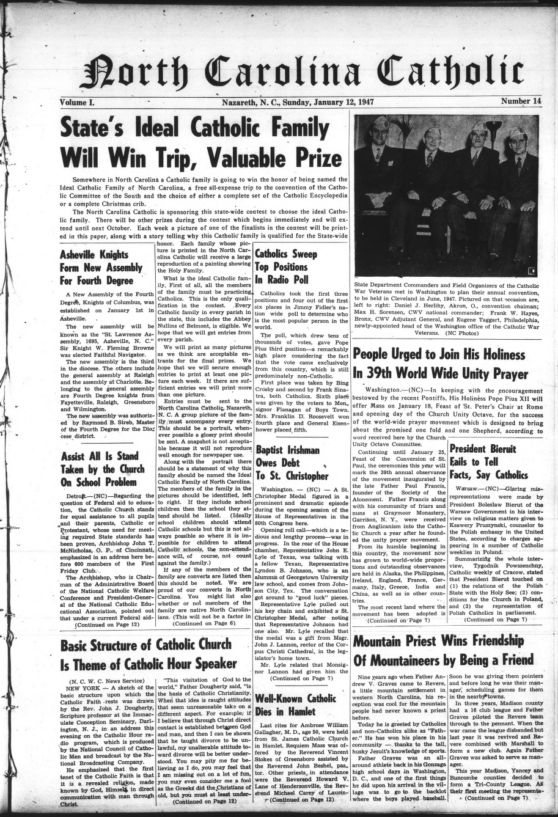
Front page of the January 12, 1947 announcing a contest looking for NC’s “ideal Catholic family”
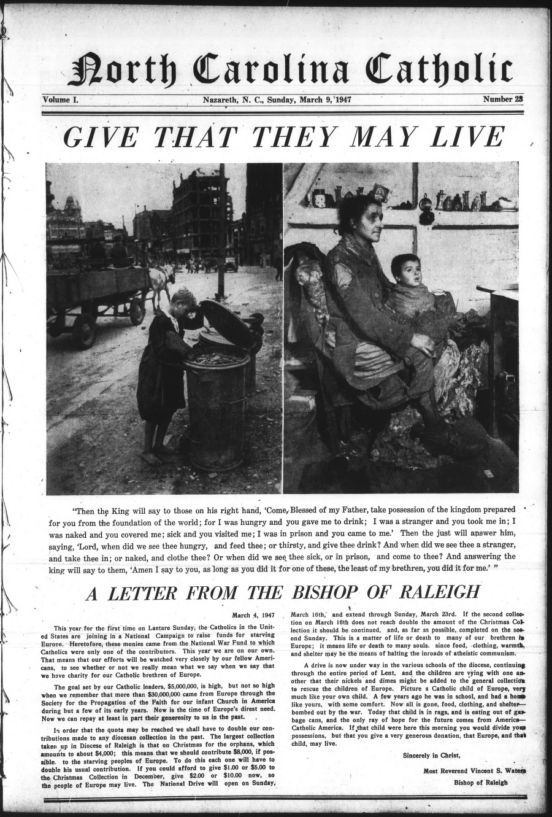
Appeal to NC Catholic’s from the Bishop, Bishop Waters, for a fundraiser for the people of post-war Europe during Lent in 1947
Thanks to our new partner, the archives at the Catholic Diocese of Raleigh, issues covering 1946-1968 of the North Carolina Catholic, a weekly publication, are now on DigitalNC. The paper, which started publication in 1946, covers news in the Diocese of Raleigh (which at the time covered the whole of the state – in 1971 the Diocese of Charlotte was started which split off the western half of the state) relating to Catholic Church matters, but other local news items as well. Baptisms, weddings and funerals across the Diocese are listed in each issue. Local and national politics is also heavily covered. The 1960 presidential election, in which John F. Kennedy was elected as the first President who was Catholic, is covered widely in the paper and has a note in the issue after the election “Hats off to the President!” Topics such as the Vatican II council, views on birth control and abortion, segregation, secularism, the Cold War and the USSR are all covered in the issues now online.
To view more North Carolina Newspapers, visit our newspapers site.
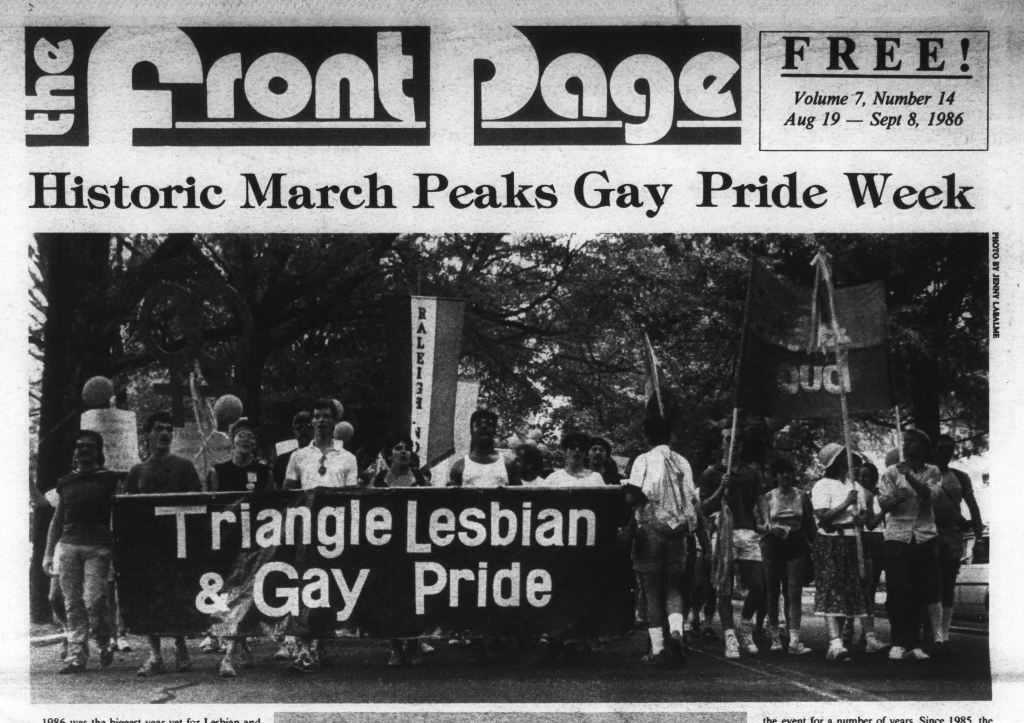 The first 8 years of The Front Page newspaper, from 1979-1986, are now on DigitalNC. The Front Page was published in Raleigh for twenty-six years covering “news and happenings of interest to gay people.” The paper covered national and local news impacting and of interest to the LGBTQ+ community. There are ads for local businesses that were safe spaces for LGBTQ+ individuals, and a community calendar listed events. There’s also a Q&A column where letters from readers all over the state wrote in with problems or questions to recieve a broad spectrum of personal advice.
The first 8 years of The Front Page newspaper, from 1979-1986, are now on DigitalNC. The Front Page was published in Raleigh for twenty-six years covering “news and happenings of interest to gay people.” The paper covered national and local news impacting and of interest to the LGBTQ+ community. There are ads for local businesses that were safe spaces for LGBTQ+ individuals, and a community calendar listed events. There’s also a Q&A column where letters from readers all over the state wrote in with problems or questions to recieve a broad spectrum of personal advice.
Q-Notes, a prominent Charlotte area LGBTQ+ newspaper and the one Front Page merged with in 2006, published a retrospective of The Front Page and an interview with the Page‘s publisher Jim Baxter in the July 29, 2006 issue. Baxter penned an article in IndyWeek shortly after the paper’s final issue, and it describes parts of his career and the history of Front Page.
The paper has been added with kind permission from the publishers and thanks to efforts by staff at the libraries at the University of North Carolina at Charlotte and Duke University. Digitization of this paper was funded by an IDEA Action Grant from UNC-Chapel Hill Libraries. Archived issues of Q-notes are available from our site, and you can view more current content at their site.
This holiday season join us here on the blog for the 12 Days of NCDHC. We’ll be posting short entries that reveal something you may not know about us. You can view all of the posts together by clicking on the 12daysofncdhc tag. And, as always, chat with us if you have questions or want to work with us on something new. Happy Holidays!
Day 6: Collections from North Carolina Religious Institutions
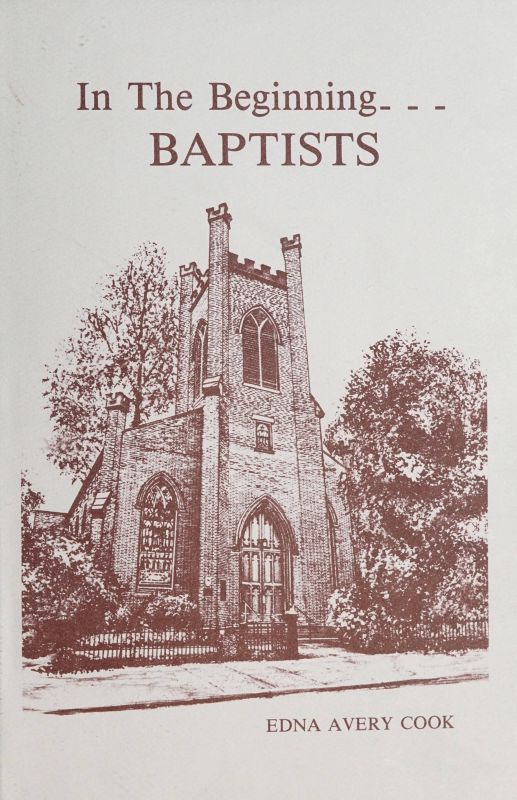 Some of our state’s oldest history is stewarded by religious institutions, and we’ve frequently been asked if we can work with them. Though most are not eligible to become an NCDHC partner because they do not have regularly open and staffed libraries or archives, we worked with our Advisory Board to devise a pilot project where eligible partner institutions can pair with a local religious institution to share their materials on DigitalNC.
Some of our state’s oldest history is stewarded by religious institutions, and we’ve frequently been asked if we can work with them. Though most are not eligible to become an NCDHC partner because they do not have regularly open and staffed libraries or archives, we worked with our Advisory Board to devise a pilot project where eligible partner institutions can pair with a local religious institution to share their materials on DigitalNC.
Our first effort was with New Bern-Craven County Public Library and the First Baptist Church of New Bern. We received a warm welcome over in New Bern as we learned about the Church’s history. We returned to Chapel Hill and scanned some of their earliest minutes along with a history of the congregation published in 1984 (pictured at right).
Here are the details if you’re interested in this project.
- The partnership must be between the religious institution and a current or eligible partner institution.
- All items we scan or photograph have to be made available through DigitalNC.org. We cannot scan items that can’t be made freely accessible online.
- This project follows the same guidelines as all of the work we do. You can read more on our “How to Participate” page.
- Items will have the eligible partner institution listed as the contact, and the religious institution as the home for the archive. We’ll make an “exhibit page” for the religious institution so they can easily search and browse their materials.
This is a great opportunity for local libraries or museums to build or enhance relationships with local synagogues, churches, mosques, and temples.
Check back on Monday as we reveal Day 7 of the 12 Days of NCDHC!
About two years ago, we had the honor of hosting a group of students from Wilmington who were studying one of the most politically and socially devastating moments in the state’s history–the Wilmington Coup and Race Riots of 1898. Their efforts centered around locating and studying the remaining issues of the newspaper at the center of that event, the Wilmington Daily Record. Owned and operated by African Americans, this successful paper incited racists who were already upset with the political power held by African Americans and supporters of equality. During the Coup, the Record’s offices were burned and many were killed. Thanks to these students, their mentors, and cultural heritage institutions, you can now see the seven known remaining issues of the Daily Record on DigitalNC.
Our main contact on this project has been John Jeremiah Sullivan, a well known North Carolina author and editor. He originally approached us back in 2017 to enlist our help and, since then, has been working with a cohort of supporters, volunteers, and students to dig deeper into the Daily Record and to raise further awareness of its history. Today we’re excited to share the Project’s latest efforts in Sullivan’s own words below.
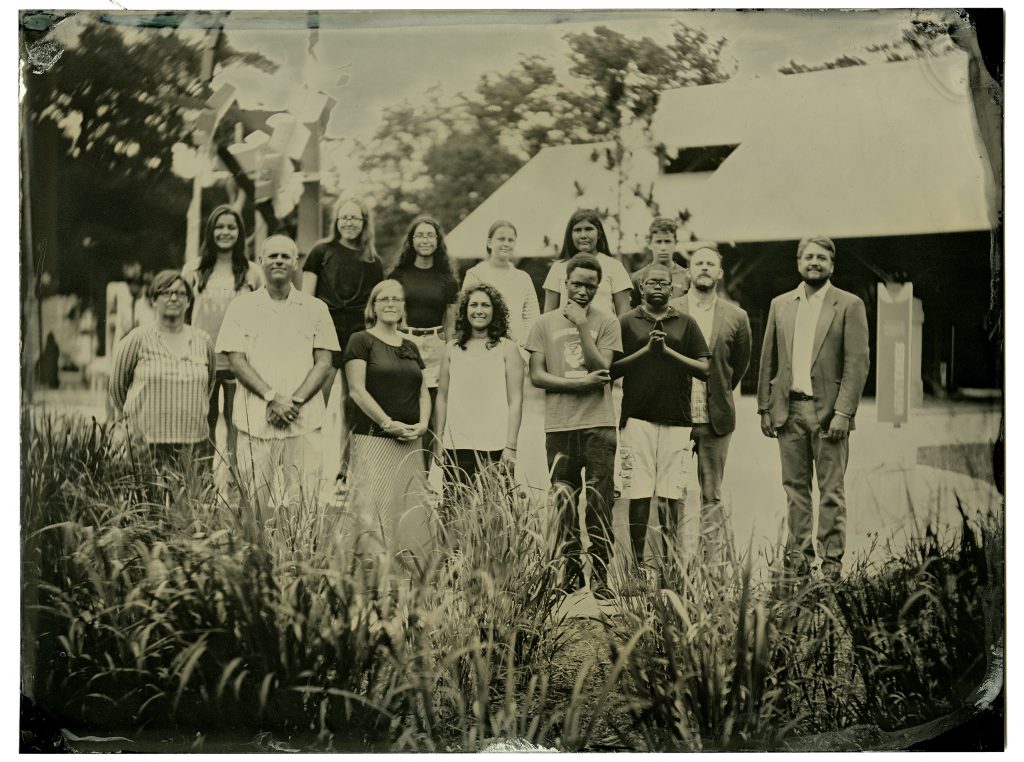
Daily Record Project Historians, taken by Harry Taylor in May 2017 at the Cape Fear Museum
Highlights
- Over the past few years, Wilmington middle school students have been combing through newspapers, periodicals, manuscripts, and other publications contemporaneous with The Daily Record searching for content from the Record that is quoted in those sources.
- Their efforts yielded numerous quotes, which have been assembled into what they’re calling a “Remnants” issue of the Record.
- Literary content, biographical information about the Record’s editors, Wilmington political news and more can be found in this issue.
- For the first time in one place you can read content that was published in issues of the Record that may no longer exist.
The Daily Record Project
by John Jeremiah Sullivan
“For the past four years, Joel Finsel and I, in conjunction with the Third Person Project, have been meeting weekly with groups of Wilmington 8th-graders to learn as much as we can about the Wilmington Daily Record, the African American newspaper destroyed at the start of the race massacre and coup d’état that turned Wilmington upside down in November of 1898. At the heart of the original Daily Record Project was an attempt to locate any surviving copies of the paper. Books and essays about the massacre always include a sentence along the lines of, ‘Sadly no copies remain,’ but it seemed impossible that they could all have disappeared. After three years’ hunting, we were able to identify seven copies–three in Wilmington, at the Cape Fear Museum (the staff historian there reached out to make us aware of their existence), three at the Schomburg Center for Research in Black Culture in New York City, and one at the State Archives of North Carolina in Raleigh. (The latter is a mostly illegible copy of the issue containing Alex Manly’s editorial of August 18, 1898, the article seized on by white supremacists as a pretext for stirring up race-hatred in the months before the massacre.) These seven copies, thanks to the North Carolina Digital Heritage Center, can now be examined online by anyone with an Internet connection. For the first time in more than a hundred years, it is possible to read one of the most famous and important African American newspapers of the late-nineteenth century.
“When those seven copies had been thoroughly read through and annotated, and it did not seem that any more were going to surface (at least not in the near future), we found ourselves faced with the question of “What next?” Should we discontinue the project? We had no desire to do that—it had been too much fun and we were learning too much. We had developed rewarding relationships with the three middle schools that sent their students to study with us: Williston School, D.C. Virgo Preparatory Academy, and the Friends School of Wilmington. The Daily Record Project had become a kind of field laboratory for excavating more information about the events of 1898 and Wilmington history more largely. The last thing we wanted was to shut that down.
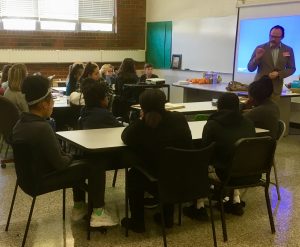
John Jeremiah Sullivan addressing the Daily Record Project class at DC Virgo Preparatory Academy, 2019
“We had noticed, in the course of studying the seven copies, that there did exist, in various sources from that period, isolated fragments of text from various issues of the Record that may no longer exist. We were finding these fragments in other newspapers. Just as publications do today, papers were reprinting one another’s material. Sometimes it was in the form of a quotation—several paragraphs, or even just a sentence. Sometimes whole articles were being re-published. In a couple of cases, the text survived by way of advertisement: a traveling circus, for instance, had liked what the Record said about it when it passed through Wilmington, and used that paragraph in announcing future appearances. We started wondering how many of these “ghost” stories might exist. The more we looked, the more we found. We enlisted the 8th graders to help us search. They turned up even more stuff. The range of sources we were using expanded. From old newspapers we moved on to magazines and books and pamphlets and letters. Often the writers or editors doing the quoting were critical of, or even hostile to, the Record and its politics. In attacking pieces from the Record that had offended them, they were unwittingly preserving more of that newspaper’s copy for future generations.
“By the time it was over, we had a folder containing scores of these “remnants,” as we were calling them, enough to create an entire new issue–a “ghost issue”–of the Daily Record, and that is what we have done.
“To create the actual issue, we worked with a brilliant graphic designer in New York named Stacey Clarkson James, who for many years had been the Art Director at Harper’s Magazine. I had worked with Stacey at Harper’s many years ago and have collaborated with her many times since. She exceeded even our high expectations by designing a newspaper issue that is not so much an imitation of the original Daily Record as a resurrection. She went in and crafted, by hand, a typeface that matches the now-extinct one used by Alexander Manly and the original editors. Then she laid out the pages according to the old 1890s press-style, even dropping in advertisements that we knew to have appeared in the Record. At the top it says REMNANTS. We gasped when we saw it.
“On the second page, above the masthead, can be seen a list of sources we used. There are a lot of them. The very size and range of the list shows the scope of the Record’s notoriety in its day. It was being read in many parts of the country.
“Maybe the most interesting thing about this issue is that, because it consists only of material that other publications found interesting enough to re-print, it winds up forming a kind of Greatest Hits compilation (though all of these “hits” have been buried in other papers until now). It’s a fascinating issue to read. There are articles on politics, culture, and social life, as well as strange unplaceable pieces, like the one about a man in Arkansas who caught fire in his orchard and just kept burning. No one could put him out. We still aren’t sure what that one means.
“Two of many things worth highlighting within the “Remnants” issue:
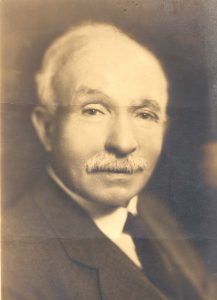
Charles W. Chesnutt, Charles Chesnutt Collection, Fayetteville State University Library.
“First–at the center of the issue is Charles Chesnutt’s short story, “The Wife of His Youth.” Chesnutt was, of course, one of the first great African-American fiction writers, and the novel that many consider to be his greatest work, The Marrow of Tradition, is a re-telling of the events of 1898, set in a fictionalized Wilmington that he calls Wellington. Chesnutt had many and deep ties to this city, more than most scholars are aware. (His cousin, Tommy Chesnutt, was the “printer’s devil” or apprentice at the Daily Record–you can find his name on the masthead on page 2.) “The Wife of His Youth” is probably Chesnutt’s best-known story. What’s curious is how we learned that it ran in the Daily Record. In Chesnutt’s published correspondence, there is a letter to Walter Hines Page, his editor at the Atlantic Monthly. It’s basically a letter of complaint: Chesnutt is telling Page that Alex Manly had reprinted the story (serially) in the Record, without having asked permission. At the time of that writing the Record had already been burnt and Manly had fled Wilmington, so Chesnutt essentially says, I guess we can give him a pass… But the complaint contained valuable information, because it tells us that the Record had an ongoing literary dimension. Manly was likely running stories and poems quite frequently—one of the seven surviving copies also contains a short story, “The Gray Steer” by one Frank Oakling. It’s on page 3 of the August 30th, 1898 issue.
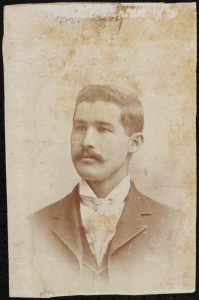
Alexander Manly, in the John Henry William Bonitz Papers #3865, Southern Historical Collection, The Wilson Library, University of North Carolina at Chapel Hill.
“Second–readers will notice that at the end of the “Remnants” issue, in the last couple of columns on the last page, there is a series of articles from not the Wilmington Daily Record but the *Washington* Daily Record. These represent probably the most exciting discovery we made during this most recent session of the Daily Record Project. The way the story of 1898 traditionally gets told, the massacre and coup d’état marked the end of the Manly brothers’ journalistic careers: they left the city, their ambition blighted, and sank into relative obscurity. The reality could not have been more different. It turns out that the Manlys went almost immediately to Washington, D.C., and re-established the Daily Record there. Before a year was out, they had the press up and running. They operated the Daily Record for four more years in the capital, then handed it off to another editor, who ran it for another six or seven. One of their articles included here is a stirring anti-imperialist denunciation of American military intervention in the Philippines. Another describes the renaissance in African-American literary activity that was felt to be happening around the turn of the century. As far as we can determine, these few pieces represent the only extant copy from the *Washington* Daily Record, for its entire decade-long run.
“There is much more worth unpacking, but we want to allow visitors to the NC Digital Heritage Center’s website to have the fun of doing that themselves.
“Long live the Daily Record. Thank you for reading.
“There are a lot of people to thank. First, the incredible 8th-grade students participated in the “Remnants” session of the Daily Record Project. It was a privilege to work with them and be around their energy:
- Ridley Edgerton
- Bella Erichsen
- Dymir Everett
- Love Fowler
- Malakhi Gordon
- Heaven Loftin
- Katy McCullough
- Juan Mckoy
- Shalee Newell
- Isis Peoples
- Nakitah Roberts
- Gabe Smith
- Maria Sullivan
- Latara Walker
- Ramya Warren
“Second, the adults (teachers, administrators, chaperones, donors, friends, and Third Person Project members) who contributed every week to making this year’s work possible:
- Rhonda Bellamy
- Dan Brawley
- Laura Butler
- Stacey Clarkson James
- Michelle Dykes
- Clyde Edgerton
- Brenda Esch
- Joe Finley
- Cameron Francisco
- Sabrina Hill-Black
- Mariana Johnson
- Trey Morehouse
- Tana Oliver
- Donyell Roseboro
- Elliot Smith
- Beverley Tetterton
- Larry Reni Thomas
- Candace Thompson
- Leyna Varnum
- Tony Ventimiglia
- Florence Weller
- The Cape Fear Museum
- NC State Archives
- The Schomburg Center
“And finally, a shout-out to the Digital Heritage Center. Thanks to you, more than 120 years after white supremacists tried to erase the Daily Record, people are reading it again.”
We frequently get asked by institutions “what should I do with my scanned photos/documents?” This is a great question but not an easy one – digitization/scanning is the easy part.
What these institutions are often asking is how they should keep track of the files they created during scanning (scans) and the information about what they scanned (metadata). In addition to tracking, they’d like to know what their options are for sharing the scans and metadata with an online audience.
When you see websites like ours with extensive collections of scans paired with metadata (like in the screenshot below), there’s usually a piece of software behind it that keeps track of the scans and the metadata and then matches them up for online display. That’s what a content management systems (CMS) does, if you’ve heard that term before. The benefit of using a CMS is that it makes sure the scans and their metadata remain paired over time, and often allows users to do fun things like search, sort, and filter.
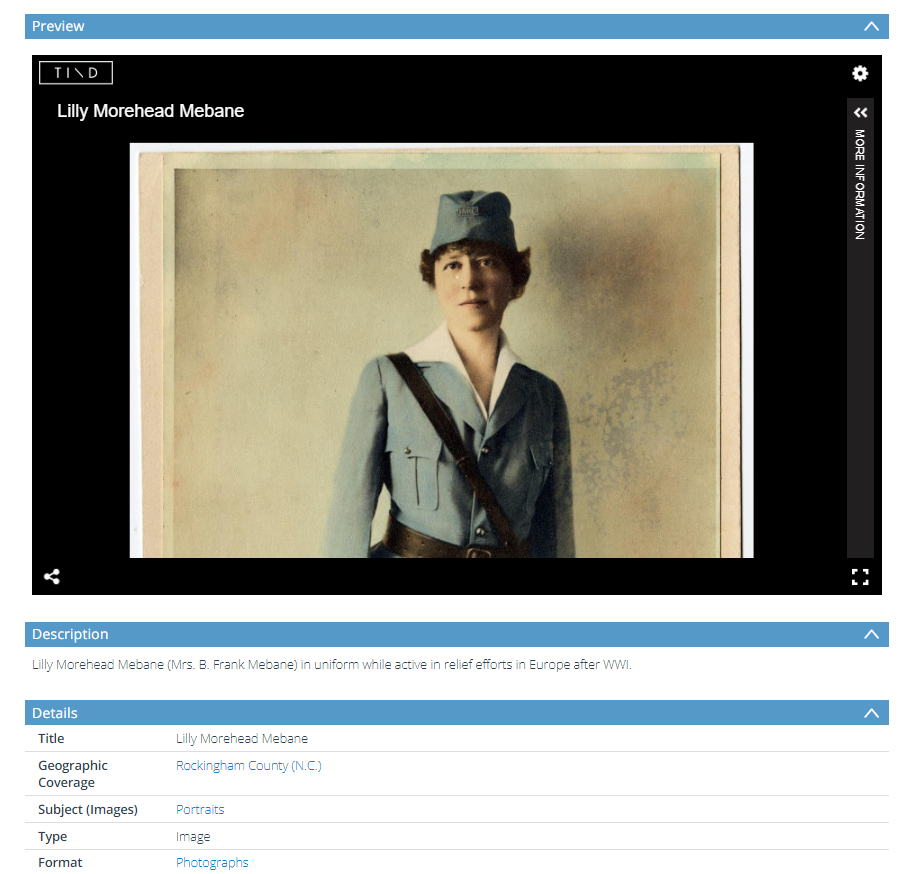
Screenshot of an item on DigitalNC, as presented by a content management system called TIND.
There are different types of CMSs for different types of industries. This post focuses on options for cultural heritage institutions, because CMSs made for cultural heritage institutions generally address the things we care about most. They make sure metadata is shareable, that scans can be described really well, and that you can express one-to-many relationships (think: many scans linked up to a single metadata record).
If your institution is considering implementing a CMS, here are the very first steps we suggest considering.
First, Plan
- Decide on your goals. Do you want your scans to be available online? Or are you just looking for software that will manage your scans and metadata locally? Who will use the end product – your staff, your patrons/users, or both? Your answer will help guide where you go next.
- Do some prep work. Like any other service your institution wants to maintain, figure out (1) how much money you have to spend both now and on an ongoing basis, (2) who will need to be involved in installation and support, and (3) what staff expertise you already have related to technology.
- Talk to your administration and coworkers. What are their goals and needs for scanning and sharing those scans, if any? It’s a lot harder to implement a system if you don’t have the buy-in of others where you work.
- Be realistic. Start small and build up your capacity. We’ve never heard of someone saying “our first scanned collection was too small,” but we have heard a lot of people say “I bit off way more than we could chew.”
Options for Keeping Track of Scans Locally
If you just need to keep track of scans and metadata locally for staff use, you can do this easily with a spreadsheet and a really consistent file naming structure. The spreadsheet could include things like a title or description, maybe a physical location, any other helpful keywords or dates, and the file or folder names for the scans. Staff can search the spreadsheet for what they need, and then find the file or folder name so they can pull up the scans from storage.
If you’d like something more sophisticated for keeping track of scans and metadata locally for staff use, there are programs that allow you to tag and describe scans that live locally. If you search for “photo management software” or “photo organizing software” online you’ll discover a number of options. We’re not terribly familiar with these; just be sure that you can export whatever you put into the software before committing.
Options for Putting Scans Online
If you decide you’d like to put your scans online, here are some choices you can consider.
A Content Management System Already in Place
Examples Include: LibGuides (screenshot below), library catalogs, museum databases
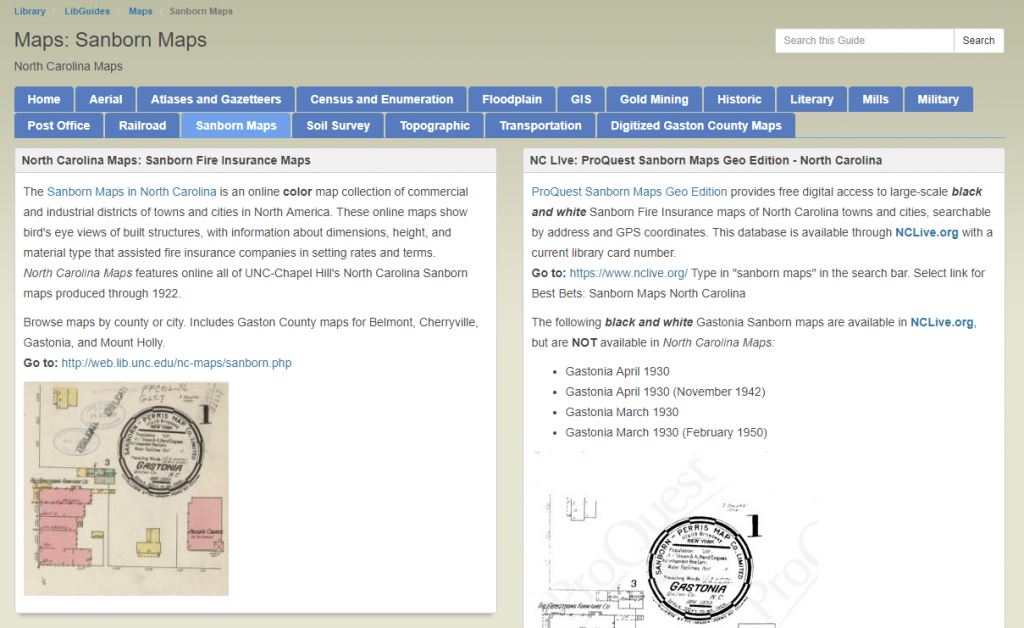
Screenshot of a LibGuide with extensive information about North Carolina maps.
Typically Chosen By: Institutions who already have a CMS that they can stretch to serve their needs.
The Positive Side: You may be able to start sharing your scans faster because the CMS is already adopted and paid for by your institution and familiar to staff and online users.
Possible Challenges: LibGuides, library catalogs, and museum databases do not always follow best practices and standards for digital collections. For example, it may not allow you to attach multiple scans to a single record, or it may not export your metadata in a structured way. In other words, you may be fitting a “square peg into a round hole.” In addition, if the features you want to use are secondary to the system’s main purpose, the vendor or developer could drop those features later.
Recommended? Depending on your resources and needs this can be the best solution. Just be aware of the possible down sides mentioned above.
A Social Media or Photo Sharing Website
Examples Include: Facebook, Flickr (Screenshot below), Tumblr
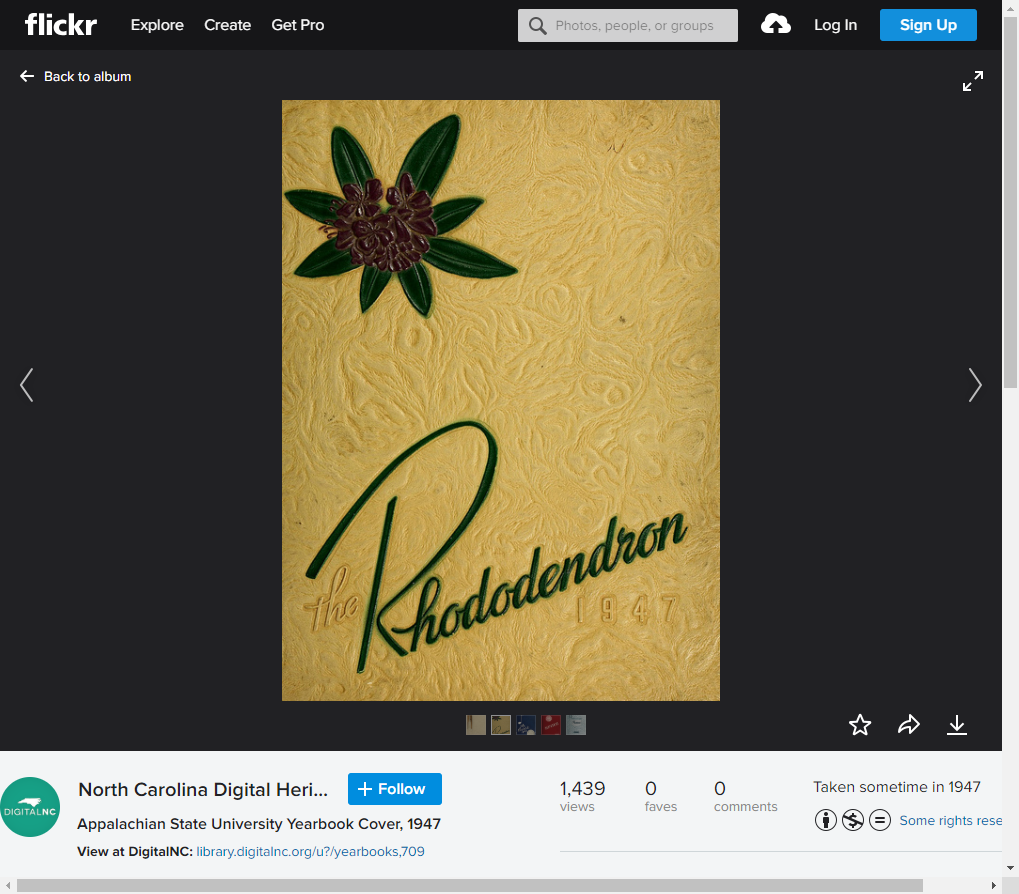
Screenshot of an item on Flickr.
Typically Chosen By: Private individuals, small organizations with limited technical staff, institutions seeking to engage with broad communities where those communities already congregate online.
The Positive Side: These reach broad, built-in audiences. There is frequently no cost up front.
Possible Challenges: These do not adhere to best practices and standards for digital collections, which can cause a lot of work later on. Sites like these can shut down or change their terms of service with little or no regard for or warning to users. There are ads displayed near to your files, over which your organization has no control. It’s frequently impossible or extremely difficult to get your files and metadata back out of these sites.
Recommended? Not recommended as the main mechanism for managing and storing your files and metadata. These sites are best used only for outreach and engagement.
Hosting your Content on DigitalNC.org
Typically Chosen By: Institutions of all sizes who prefer not to host their own software, possibly due to local IT limitations or as a result of strategic priorities; institutions who would like their scans and metadata searchable alongside others from around the state.
The Positive Side: Your content reaches a broad, built-in audience. It would be searchable with similar digital collections from around North Carolina. Currently no cost to institutions.
Possible Challenges: We do the uploading and editing for you, and it takes place within a broader schedule. We’d ask you to create images and metadata that follow our standards before we could upload. (These could be positives, depending on your perspective.)
Recommended? Sure! Depending on your resources and needs this can be a great option.
A Content Management System Hosted by an External Company
Examples Include: CONTENTdm (screenshot below), hosted Islandora, ArtStor’s JSTOR Forum, Omeka.net, Past Perfect Online, or TIND (which is what we use, see screenshot at the beginning of this post)
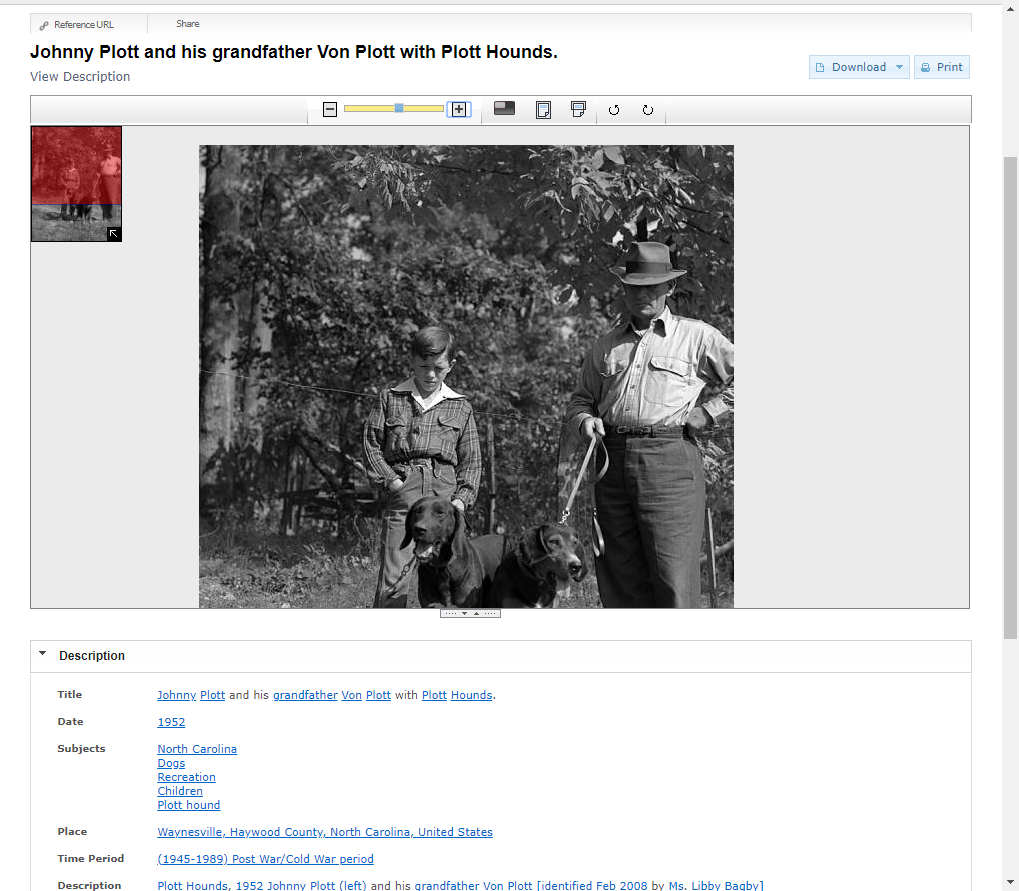
Screenshot of a hosted instance of CONTENTdm.
Typically Chosen By: Institutions of all sizes who prefer not to host their own software, possibly due to local IT limitations or as a result of strategic priorities.
The Positive Side: Many systems like these are built with best practices like consistency, standards, and integration with other systems. They will allow users to search your metadata, and often offer things like filtering, file downloading, and other desired user services. Your organization does not have to set up or maintain the software locally. You can establish a brand and dedicated site for your digital collections.
Possible Challenges: They require staff with specialized training in the system, and the ability to pay a vendor both initially and on an ongoing basis. You’re limited to the services or features the vendor chooses to offer.
Recommended? Sure! Depending on your resources this can be a great option.
Hosting Your own Content Management System
Examples Include: Self-hosted Islandora, Omeka (screenshot below), Samvera, Collective Access
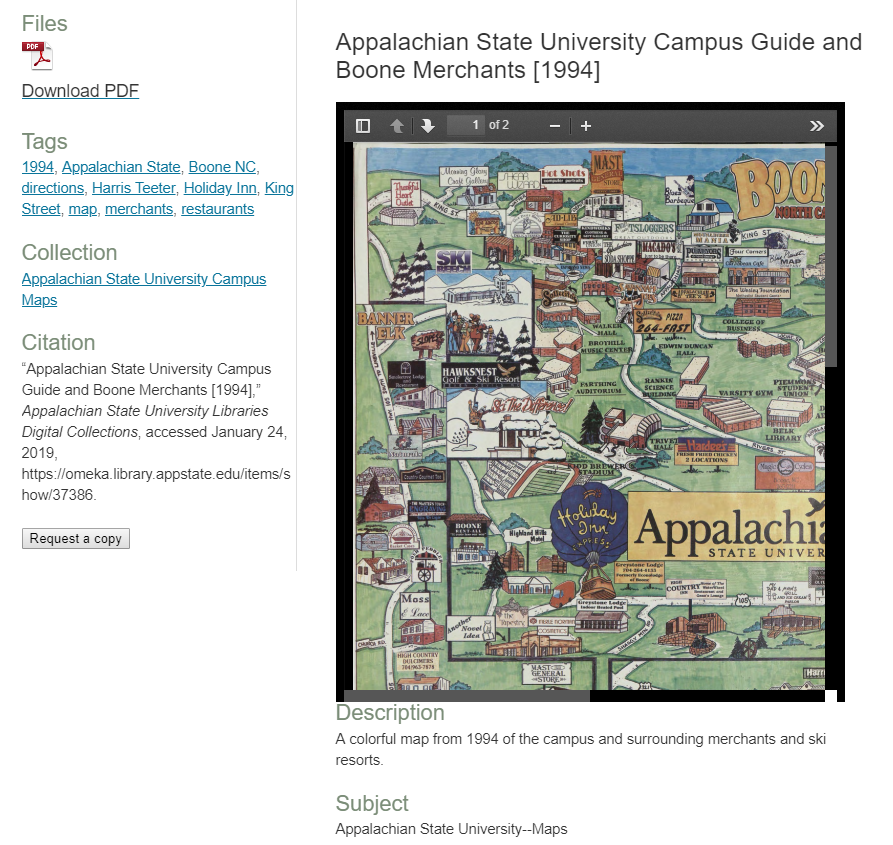
Screenshot of a self-hosted instance of Omeka.
Typically Chosen By: Institutions with programmers on staff, dedicated IT support, and collections that require a lot of customization.
The Positive Side: Like the hosted systems above, these are also often built with best practices like standards and interoperability. They will allow users to search your metadata, and often offer things like filtering, image downloading, and other user services. When you host your own system you can frequently customize more features.
Possible Challenges: They require staff with specialized training, and a robust and flexible IT support infrastructure. They’re more time intensive and costly to maintain.
Recommended? Sure! Depending on your resources and needs this can be a great option.
Final Thoughts
In the end, there isn’t much that’s an “always wrong” choice. There are only choices that have different consequences down the road. We encourage people to choose the systems that adhere to digital collections best practices, because those best practices come from people who’ve made choices they regretted. In the end, it’s most important to choose a solution that meets your needs and fits the resources you have now and those you anticipate having in the future. Above all, always be sure that your scans and metadata are backed up and can be extracted from the system you choose!
Did we miss anything? Leave us a comment below.
If you’re considering one or more of these and have questions, get in touch. We’re happy to give you advice for what to ask a vendor or point you to similar institutions who may have already adopted what you’re considering.
Here at the Digital Heritage Center, we’re able to scan or photograph almost all kinds of two dimensional items and even a goodly number of those in three dimensions. However, audiovisual materials are sent off site for digitization to a vendor and, as such, it’s a service we’ve only been able to offer annually. We just concluded our second round of audiovisual digitization and, like last year, our partners came forward with a wide variety of film and audio nominations. This is the second in a series of posts about the accepted nominations, with links to the items in the Sights and Sounds collection.
State Archives of North Carolina
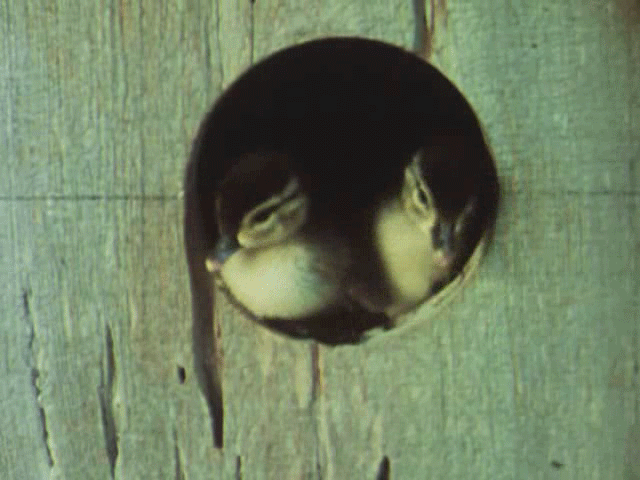
One of the best parts of “Wildlife Babies” is the footage of baby ducks jumping out of their bird house into a lake.
Appropriate for this election season, the State Archives has shared a number of short spots from the 1968 Governor’s race in which Robert W. Scott compares his policies and campaign tactics to those of his opponent, Jim Gardner. Scott’s criticisms of Gardner and his campaign echo some of what we hear today, and are also reflective of pressing issues in the state at the time, ranging from criticisms about Gardner’s attendance record to “misleading” campaign literature in which Scott was shown standing next to an African American man. There is also footage of a campaign speech made by Scott in Greenville, North Carolina, shortly before election day.
In addition to these are shared a number of films from the Wildlife Resources Commission. Many show both freshwater and saltwater fishing, both for sport and science. If you need your baby animal fix, you can check out “Wildlife Babies,” an award-winning feature that shows baby birds and mammals of North Carolina.
Mauney Memorial Library
We are always pleased to uncover and make available more films by H. Lee Waters, and during this round of digitization the Mauney Memorial Library came forward with two such films from Kings Mountain, N.C. These two most recent films are similar in style to the many produced by Waters, available both here and through an astounding collection at Duke University Libraries. There are many shots of school children walking in front of the camera, sometimes shy, sometimes silly. Some notable features include an aerial view of Kings Mountain, views inside local stores, and a product demonstration of a refrigerator (minute 26).
We’ll be posting several more blog posts in the coming weeks which will introduce the other films from our partners now viewable on DigitalNC.
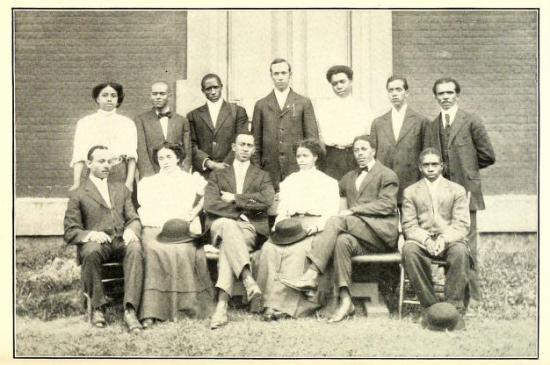
Students at Shaw University, 1911.
With the recent addition of student yearbooks from Livingstone College, DigitalNC now hosts historic materials from ten different Historically Black Colleges and Universities in North Carolina. These materials document more than a century of African American higher education in North Carolina. From our earliest projects in 2010 to the present, the North Carolina Digital Heritage Center has worked closely with libraries and archives at historically Black colleges around the state, and we continue to add materials from these collections on a regular basis. Follow the links below to browse yearbooks, newspapers, photos, scrapbooks, and more materials by school.
Bennett College (Greensboro)
Elizabeth City State University
Fayetteville State University
Johnson C. Smith University (Charlotte)
Livingstone College (Salisbury)
North Carolina A&T (Greensboro)
North Carolina Central University (Durham)
Saint Augustine’s University (Raleigh)
Shaw University (Raleigh)
Winston-Salem State University
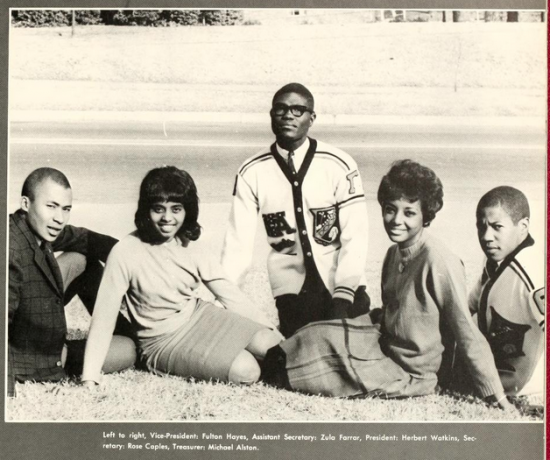
Sophomore class officers at North Carolina Central University, 1963.

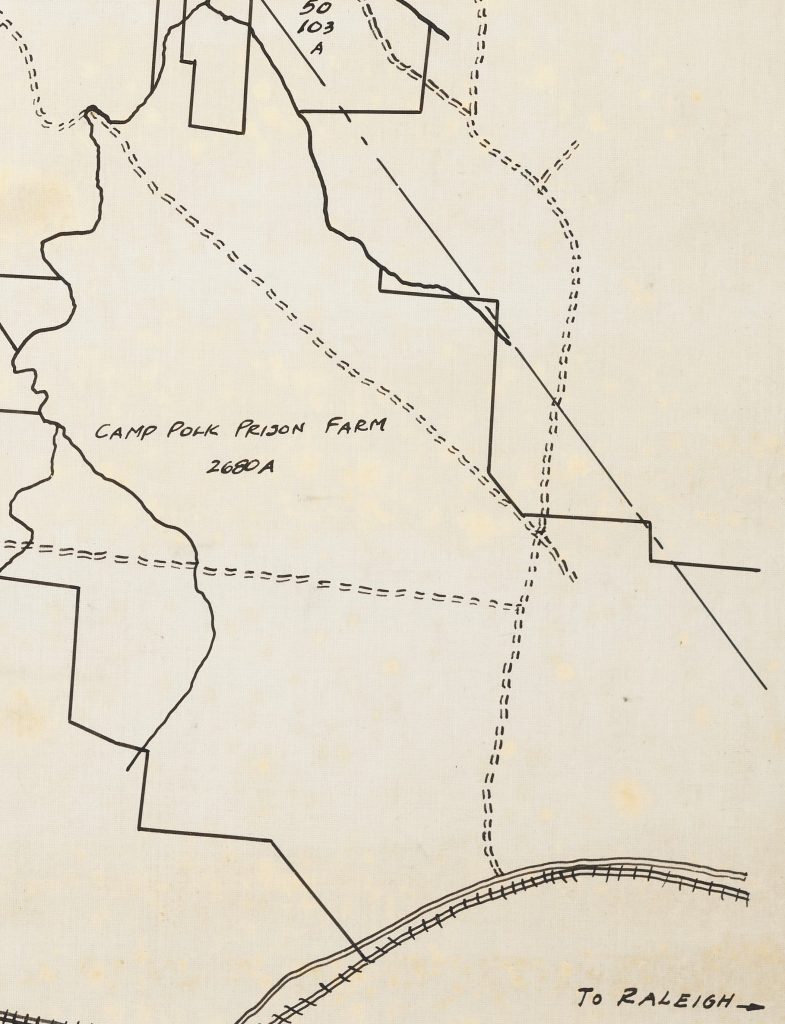


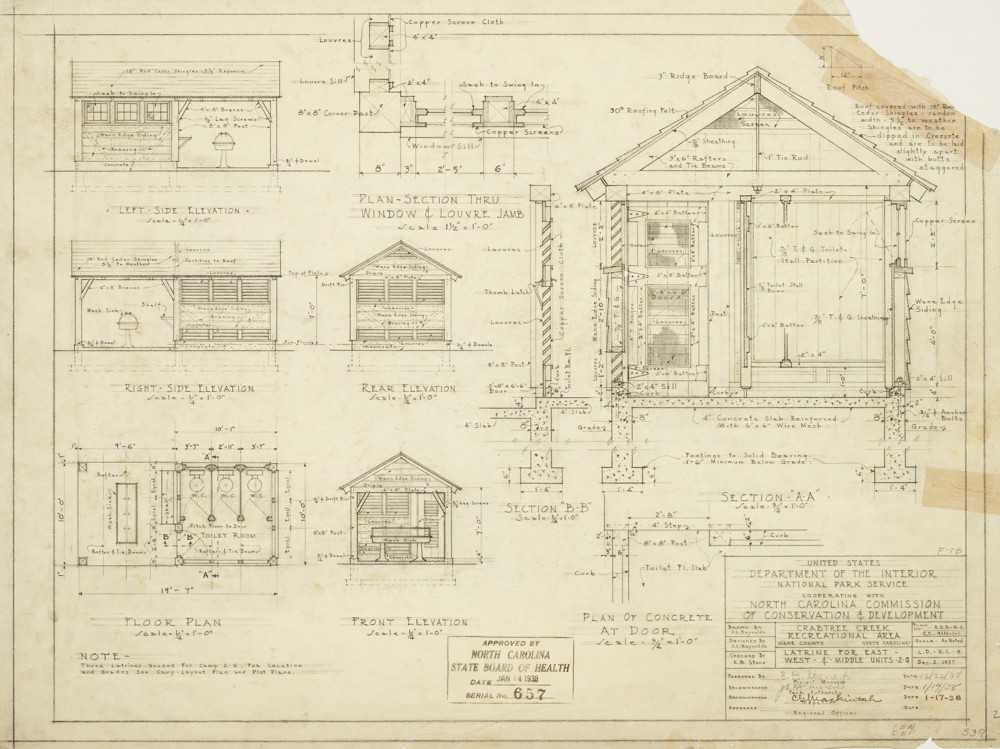
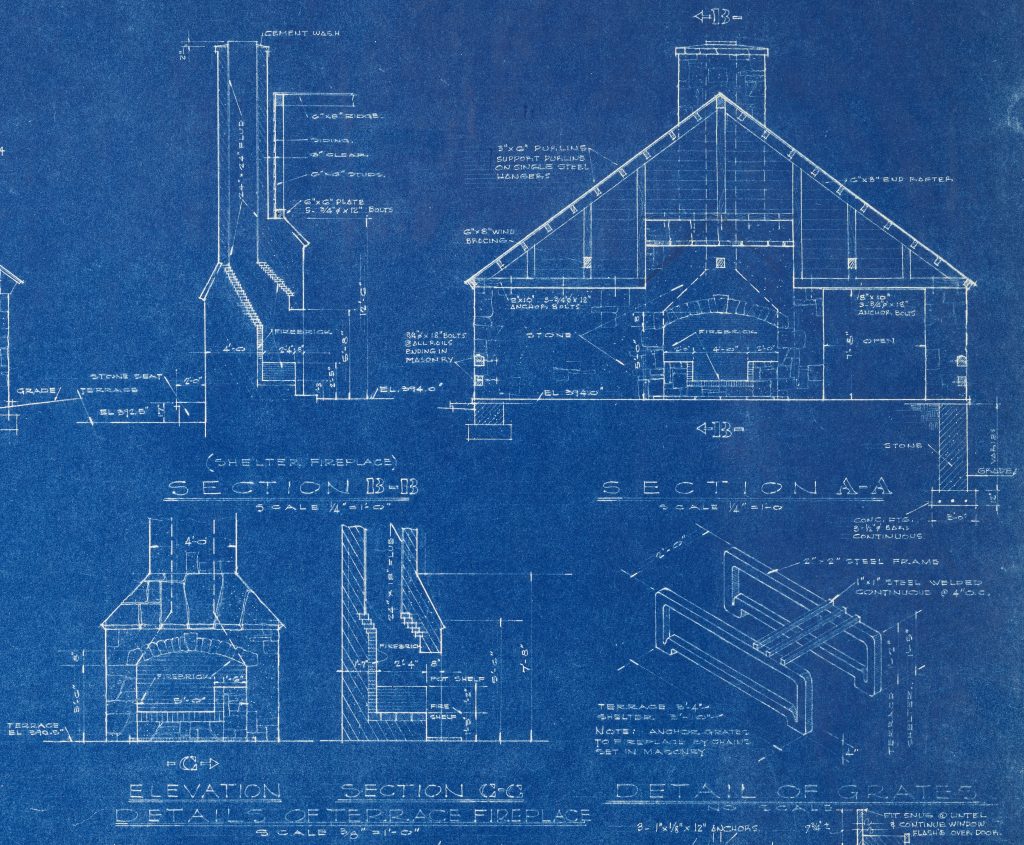
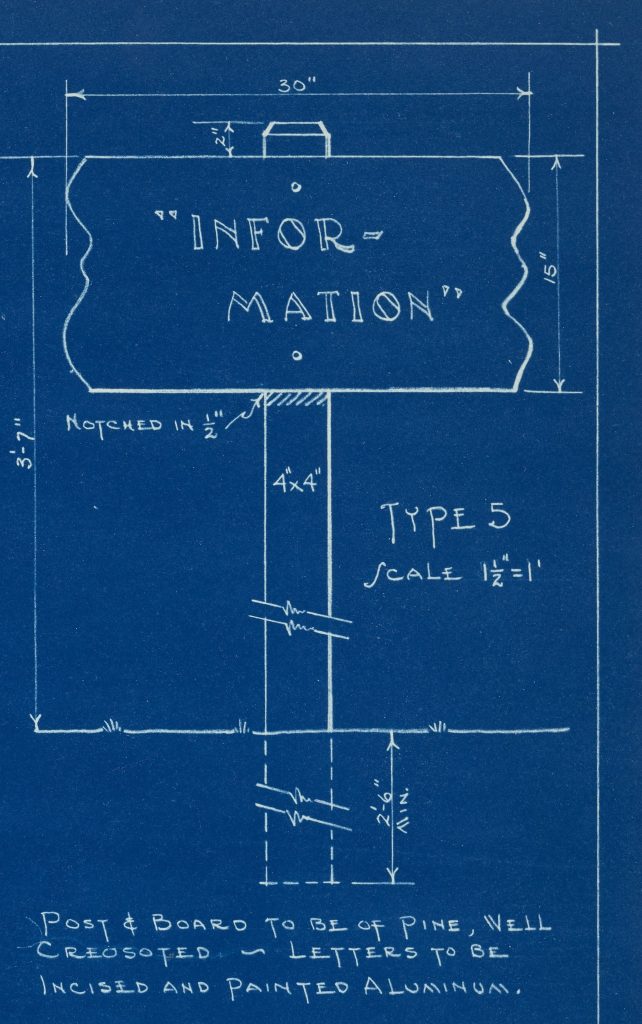


 The
The 












